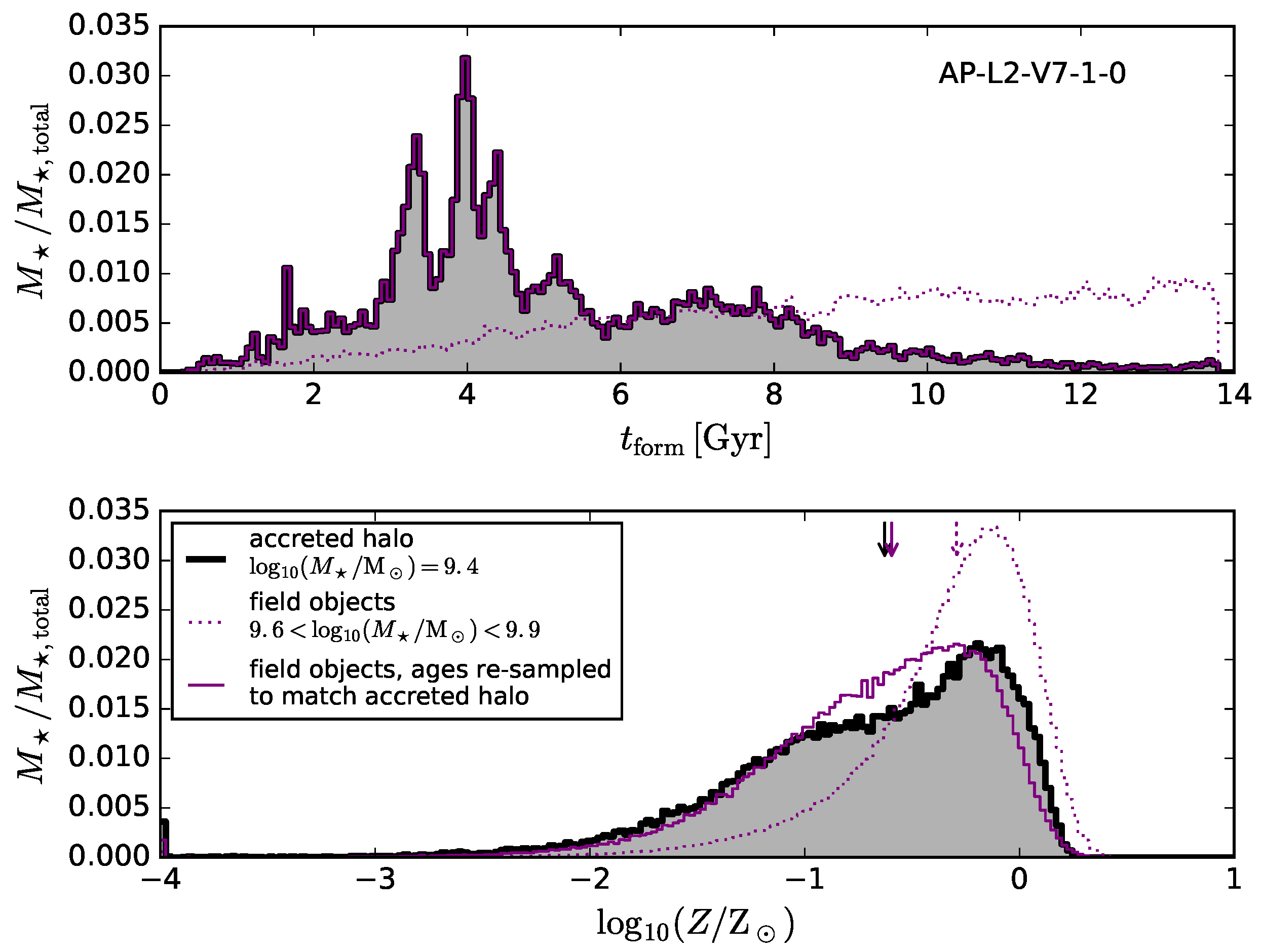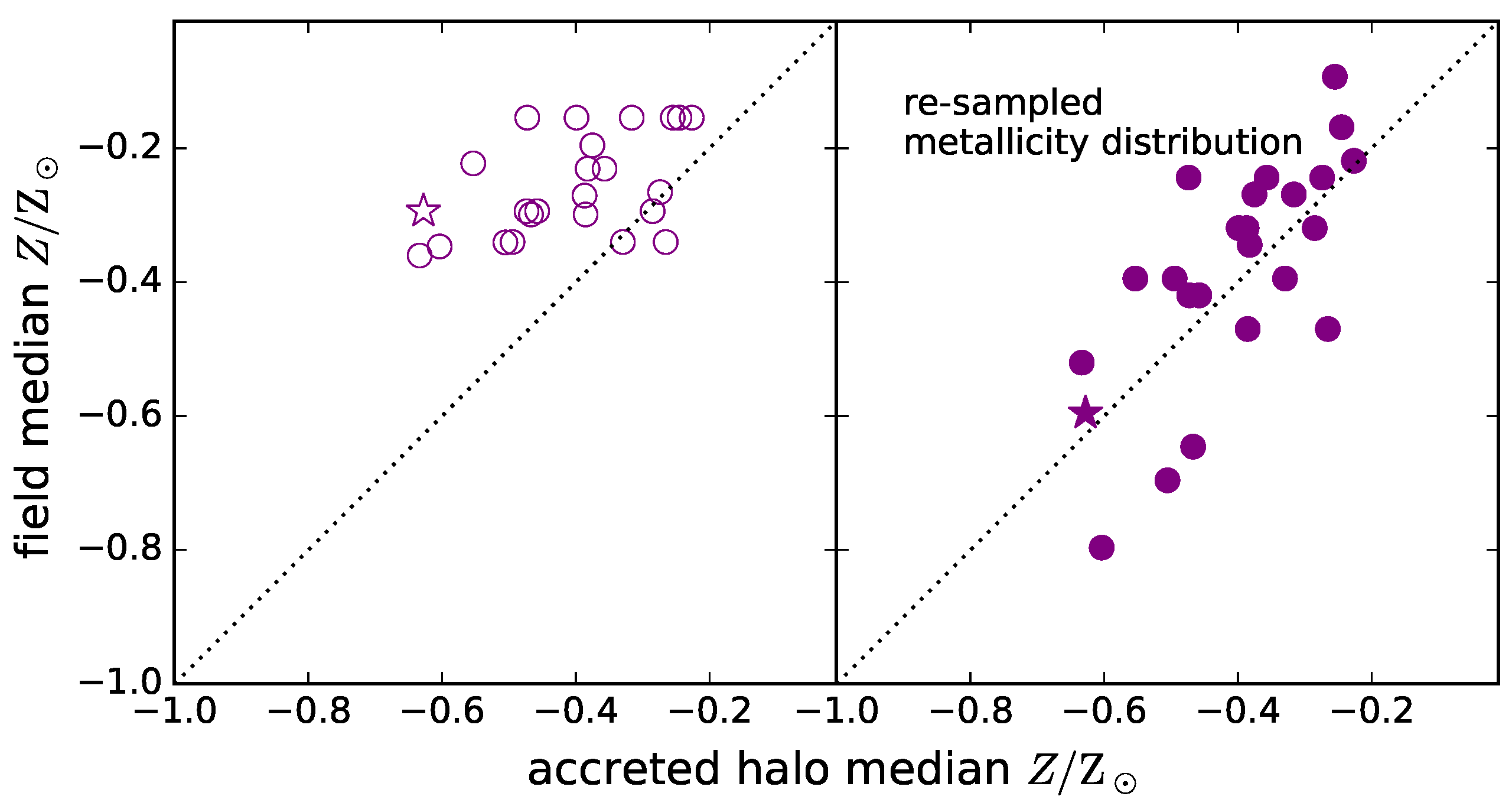The “Building Blocks” of Stellar Halos
Abstract
:1. Introduction
2. Materials and Methods
3. Results
4. Discussion
Acknowledgments
Author Contributions
Conflicts of Interest
References
- Renda, A.; Gibson, B.K.; Mouhcine, M.; Ibata, R.A.; Kawata, D.; Flynn, C.; Brook, C.B. The stellar halo metallicity-luminosity relationship for spiral galaxies. Mon. Not. R. Astron. Soc. 2005, 363, L16–L20. [Google Scholar] [CrossRef]
- Font, A.S.; Johnston, K.V.; Bullock, J.S.; Robertson, B.E. Phase-Space Distributions of Chemical Abundances in Milky Way-Type Galaxy Halos. Astrophys. J. 2006, 646, 886–898. [Google Scholar] [CrossRef]
- Robertson, B.; Bullock, J.S.; Font, A.S.; Johnston, K.V.; Hernquist, L. Λ Cold Dark Matter, Stellar Feedback, and the Galactic Halo Abundance Pattern. Astrophys. J. 2005, 632, 872–881. [Google Scholar] [CrossRef]
- Deason, A.J.; Mao, Y.Y.; Wechsler, R.H. The Eating Habits of Milky Way-mass Halos: Destroyed Dwarf Satellites and the Metallicity Distribution of Accreted Stars. Astrophys. J. 2016, 821, 5. [Google Scholar] [CrossRef]
- D’Souza, R.; Bell, E. Accreted Metallicity-Stellar Mass Relationship. arXiv, 2017; arXiv:1705.08442. [Google Scholar]
- Harmsen, B.; Monachesi, A.; Bell, E.F.; de Jong, R.S.; Bailin, J.; Radburn-Smith, D.J.; Holwerda, B.W. Diverse stellar haloes in nearby Milky Way mass disc galaxies. Mon. Not. R. Astron. Soc. 2017, 466, 1491–1512. [Google Scholar] [CrossRef]
- Sawala, T.; Frenk, C.S.; Fattahi, A.; Navarro, J.F.; Bower, R.G.; Crain, R.A.; Dalla Vecchia, C.; Furlong, M.; Helly, J.C.; Jenkins, A.; et al. The APOSTLE simulations: solutions to the Local Group’s cosmic puzzles. Mon. Not. R. Astron. Soc. 2016, 457, 1931–1943. [Google Scholar] [CrossRef]
- Fattahi, A.; Navarro, J.F.; Sawala, T.; Frenk, C.S.; Oman, K.A.; Crain, R.A.; Furlong, M.; Schaller, M.; Schaye, J.; Theuns, T.; et al. The APOSTLE project: Local Group kinematic mass constraints and simulation candidate selection. Mon. Not. R. Astron. Soc. 2016, 457, 844–856. [Google Scholar] [CrossRef]
- Komatsu, E.; Smith, K.M.; Dunkley, J.; Bennett, C.L.; Gold, B.; Hinshaw, G.; Jarosik, N.; Larson, D.; Nolta, M.R.; Page, L.; et al. Seven-year Wilkinson Microwave Anisotropy Probe (WMAP) Observations: Cosmological Interpretation. Astrophys. J. Suppl. 2011, 192, 18. [Google Scholar] [CrossRef]
- Schaye, J.; Crain, R.A.; Bower, R.G.; Furlong, M.; Schaller, M.; Theuns, T.; Dalla Vecchia, C.; Frenk, C.S.; McCarthy, I.G.; Helly, J.C.; et al. The EAGLE project: Simulating the evolution and assembly of galaxies and their environments. Mon. Not. R. Astron. Soc. 2015, 446, 521–554. [Google Scholar] [CrossRef]
- Crain, R.A.; Schaye, J.; Bower, R.G.; Furlong, M.; Schaller, M.; Theuns, T.; Dalla Vecchia, C.; Frenk, C.S.; McCarthy, I.G.; Helly, J.C.; et al. The EAGLE simulations of galaxy formation: Calibration of subgrid physics and model variations. Mon. Not. R. Astron. Soc. 2015, 450, 1937–1961. [Google Scholar] [CrossRef]
- Hopkins, P.F. A general class of Lagrangian smoothed particle hydrodynamics methods and implications for fluid mixing problems. Mon. Not. R. Astron. Soc. Lett. 2013, 428, 2840–2856. [Google Scholar] [CrossRef]
- Wiersma, R.P.C.; Schaye, J.; Smith, B.D. The effect of photoionization on the cooling rates of enriched, astrophysical plasmas. Mon. Not. R. Astron. Soc. 2009, 393, 99–107. [Google Scholar] [CrossRef]
- Schaye, J. Star Formation Thresholds and Galaxy Edges: Why and Where. Astrophys. J. 2004, 609, 667–682. [Google Scholar] [CrossRef]
- Schaye, J.; Dalla Vecchia, C. On the relation between the Schmidt and Kennicutt-Schmidt star formation laws and its implications for numerical simulations. Mon. Not. R. Astron. Soc. 2008, 383, 1210–1222. [Google Scholar] [CrossRef]
- Wiersma, R.P.C.; Schaye, J.; Theuns, T.; Dalla Vecchia, C.; Tornatore, L. Chemical enrichment in cosmological, smoothed particle hydrodynamics simulations. Mon. Not. R. Astron. Soc. 2009, 399, 574–600. [Google Scholar] [CrossRef]
- Dalla Vecchia, C.; Schaye, J. Simulating galactic outflows with thermal supernova feedback. Mon. Not. R. Astron. Soc. 2012, 426, 140–158. [Google Scholar] [CrossRef]
- Haardt, F.; Madau, P. Modelling the UV/X-ray cosmic background with CUBA. In Clusters of Galaxies and the High Redshift Universe Observed in X-rays, Proceedings of the XMM-Newton and Chandra, XXXVIth Rencontres de Moriond, XXIst Moriond Astrophysics Meeting, Savoie, France, 10–17 March 2001; Neumann, D.M., Tran, J.T.V., Eds.; CEA: Gif-sur-Yvette, France, 2001; p. 64. [Google Scholar]
- Davis, M.; Efstathiou, G.; Frenk, C.S.; White, S.D.M. The evolution of large-scale structure in a universe dominated by cold dark matter. Astrophys. J. 1985, 292, 371–394. [Google Scholar] [CrossRef]
- Springel, V.; White, S.D.M.; Tormen, G.; Kauffmann, G. Populating a cluster of galaxies-I. Results at z = 0. Mon. Not. R. Astron. Soc. 2001, 328, 726–750. [Google Scholar] [CrossRef]
- Dolag, K.; Borgani, S.; Murante, G.; Springel, V. Substructures in hydrodynamical cluster simulations. Mon. Not. R. Astron. Soc. 2009, 399, 497–514. [Google Scholar] [CrossRef]
- Helly, J.C.; Cole, S.; Frenk, C.S.; Baugh, C.M.; Benson, A.; Lacey, C. Galaxy formation using halo merger histories taken from N-body simulations. Mon. Not. R. Astron. Soc. 2003, 338, 903–912. [Google Scholar] [CrossRef] [Green Version]
- An, D.; Beers, T.C.; Johnson, J.A.; Pinsonneault, M.H.; Lee, Y.S.; Bovy, J.; Ivezić, Ž.; Carollo, D.; Newby, M. The Stellar Metallicity Distribution Function of the Galactic Halo from SDSS Photometry. Astrophys. J. 2013, 763, 65. [Google Scholar] [CrossRef]
- Ibata, R.A.; Lewis, G.F.; McConnachie, A.W.; Martin, N.F.; Irwin, M.J.; Ferguson, A.M.N.; Babul, A.; Bernard, E.J.; Chapman, S.C.; Collins, M.; et al. The Large-scale Structure of the Halo of the Andromeda Galaxy. I. Global Stellar Density, Morphology and Metallicity Properties. Astrophys. J. 2014, 780, 128. [Google Scholar] [CrossRef]
- Kirby, E.N.; Cohen, J.G.; Guhathakurta, P.; Cheng, L.; Bullock, J.S.; Gallazzi, A. The Universal Stellar Mass-Stellar Metallicity Relation for Dwarf Galaxies. Astrophys. J. 2013, 779, 102. [Google Scholar] [CrossRef]
- Carollo, D.; Beers, T.C.; Placco, V.M.; Santucci, R.M.; Denissenkov, P.; Tissera, P.B.; Lentner, G.; Rossi, S.; Lee, Y.S.; Tumlinson, J. The age structure of the Milky Way’s halo. Nat. Phys. 2016, 12, 1170–1176. [Google Scholar] [CrossRef]
- Brown, T.M.; Smith, E.; Ferguson, H.C.; Rich, R.M.; Guhathakurta, P.; Renzini, A.; Sweigart, A.V.; Kimble, R.A. The Detailed Star Formation History in the Spheroid, Outer Disk, and Tidal Stream of the Andromeda Galaxy. Astrophys. J. 2006, 652, 323–353. [Google Scholar] [CrossRef]
- Monachesi, A.; Bell, E.F.; Radburn-Smith, D.J.; Bailin, J.; de Jong, R.S.; Holwerda, B.; Streich, D.; Silverstein, G. The GHOSTS survey-II. The diversity of halo colour and metallicity profiles of massive disc galaxies. Mon. Not. R. Astron. Soc. 2016, 457, 1419–1446. [Google Scholar] [CrossRef]
- Bell, E.F.; Monachesi, A.; Harmsen, B.; de Jong, R.S.; Bailin, J.; Radburn-Smith, D.J.; D’Souza, R.; Holwerda, B.W. Galaxies Grow Their Bulges and Black Holes in Diverse Ways. Astrophys. J. Lett. 2017, 837, L8. [Google Scholar] [CrossRef]
- Bland-Hawthorn, J.; Gerhard, O. The Galaxy in Context: Structural, Kinematic, and Integrated Properties. Annu. Rev. Astron. Astrophys. 2016, 54, 529–596. [Google Scholar] [CrossRef]
| 1. | A Project Of Simulating The Local Environment |
| 2. | the age of the Universe minus the age of the star |
| 3. | AP-[resolution level]-[volume number]-[FoF group number]-[subgroup number] |



© 2017 by the authors. Licensee MDPI, Basel, Switzerland. This article is an open access article distributed under the terms and conditions of the Creative Commons Attribution (CC BY) license (http://creativecommons.org/licenses/by/4.0/).
Share and Cite
Oman, K.A.; Starkenburg, E.; Navarro, J.F. The “Building Blocks” of Stellar Halos. Galaxies 2017, 5, 33. https://doi.org/10.3390/galaxies5030033
Oman KA, Starkenburg E, Navarro JF. The “Building Blocks” of Stellar Halos. Galaxies. 2017; 5(3):33. https://doi.org/10.3390/galaxies5030033
Chicago/Turabian StyleOman, Kyle A., Else Starkenburg, and Julio F. Navarro. 2017. "The “Building Blocks” of Stellar Halos" Galaxies 5, no. 3: 33. https://doi.org/10.3390/galaxies5030033





